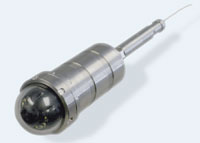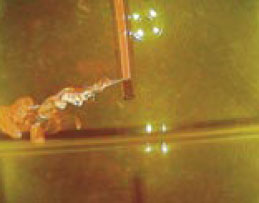 Technology from Europe: Technology from Europe:
United Kingdom
Wireline-CT and leak detection camera
David Clover, EV Offshore
 |
Fig. 1. New digital downhole camera, deployed on wireline or CT.
|
|
A new camera system for real-time downhole inspection deployable on wireline or coiled tubing (CT) is about to debut. Developed by EV Offshore, the new system is the latest addition to the company’s downhole camera inspection systems. The “wireline-CT” camera, Fig. 1, provides real-time downhole imaging for use subsea, downhole and during well interventions. A 360° rotate-and-tilt mechanism allows full, hemispherical viewing. Digital recording permits still or moving images to be transferred instantaneously over the Internet. The system can be run into a live well under well-control conditions.
The system offers real-time color or monochrome imaging at depths beyond 6,562 ft (2,000 m). The camera uses the wireline as its power, data and video transmission system, sending 25 high-resolution, color frames per second in real time.
In addition to advances in camera technology, a unique drillpipe running tool was designed to flush the periphery of the camera with clear fluid, filtered sea water, surfactants and flocculants for viewing.
The equipment is portable and easily mobilized by helicopter. The camera is mounted in the deployment tooling, whether it is a drill pipe running tool, winch, wireline or CT adaptor. The wireline is connected to the camera and a function test performed. Then, the camera is deployed through the rotary table and stuffing box lubricator, if deployed under well-control conditions.
During deployment, the camera sends real-time images to surface, which are recorded onto digital media. Real-time transmission during run-in allows evaluation of the well, casing and riser.
Deployment times vary with depth, application, deployment method and wellbore clearances. Drill pipe deployment can be range from 750 to 1,000 ft/hr; deployment on wireline can be up to 5,000 ft/hr.
As camera use rises in offshore procedures, this new technology will open new opportunities for inspection, especially under well-control situations. Mobilization will be easier and safer, because the wireline is normally present on the installation.
Cameras and monitors might also be based permanently on installations. When downhole investigation is required, trained personnel onsite will operate the equipment immediately, saving cost and time. Plus, operations will proceed far more quickly, without waiting for personnel and equipment.
The company also introduced the EVOL-SL60HT, a new subsea camera module developed to visually detect the new, highly-dispersible, red dyes being used to identify leaks in wellheads, pipelines, platforms and gas storage facilities, Fig 2. The current leak detection fluid, Fluoresceine, will likely be phased out by 2020 due to environmental concerns. Romex has developed a safe, alternative, red, trace dye for leak detection.
 |
Fig. 2. Subsea camera detects new red dyes used to identify leaks; note the LEDs in the reflection.
|
|
The new module is fitted with green LEDs that excite the dye, so external lamps aren’t needed. The camera’s optical filters interact with the color emitted when the dye is excited.
The standard camera can detect leaks in depths up to one kilometer. Measuring 2.3-in. (60 mm) in diameter and 5-in. (120 mm) in length, it weighs 1.1 lb (500 gm). The camera is completing a series of leak inspection field trials in the North Sea for a major operator. 
|

 Technology from Europe:
Technology from Europe:


